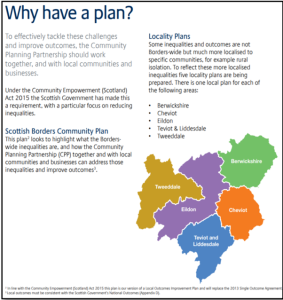A well-run, inclusive community action planning process can deliver a range of outcomes. It can:
- Build local consensus on the priority needs and opportunities that the community benefit package (and any other resources available to the community) should be directed towards
- Help local people / groups to identify a range of skills, interests and assets that exist locally, and encouraging them to build on these
- Build connections between individuals / groups and encourage further community action
- Provide an early prompt to get local groups thinking about projects they might wish to develop, and start planning those out
- Where an annual fund is involved, get some feedback on how local people see the community benefit monies being made available and on how decisions on distribution of funds might be made
- Result in a tangible output (e.g. a report, website, booklet, or a map) that can be used as a reference by local groups, for example in applying for funding, influencing the provision of services by the local authority, and so on
- Engender the widest sense of ‘ownership’ over, and support for, the community benefit package, and,
- Help local people see their community, and its future, in a positive light.
The community action planning process shouldn’t simply focus on the community benefits that are now, or soon to become, available to the community, as that may narrow or skew the community’s response. It may also mire the consultations in any residual feelings around the renewable energy development in question – perhaps in an unhelpful way.
Indeed, the plan may influence a range of resources that are, or could become, available to the community. These might include, in addition to community benefits:
- Funds that may be brought in, such as Scottish Government, lottery, or charitable trust and foundation monies;
- How public services are configured or targeted;
- Local voluntary efforts, and potentially;
- Community share or bond issues to support local projects.
These type of plans, developed through a grassroots process led by the local community, should not be confused with the statutory community planning process, led by the Community Planning Partnership (CPP), which is a collaboration of all public services in a local authority area. Each CPP is responsible for developing and delivering a Local Outcomes Improvement Plan (LOIP), which covers the whole council area and a Locality Plan for smaller areas within the CPP area, setting out how public services will be configured and delivered.
The image shown is taken from the Scottish Borders Community Plan (the LOIP) and illustrates the link between this and the Locality Plans being developed. An example of where both the LOIP and locality plans have been published is available on the Glasgow City Health and Social Care website.
Community action plans and the statutory community planning process don’t necessarily have a formal relationship with each other. Usually, the local community action plan will be deemed to have more direct relevance to the local community, having been developed by them and being focused on action that they themselves can take rather than outside agencies.

The effective delivery of community action plans may involve collaboration with, or influencing the provision of, statutory services. It may be appropriate for community benefits to at times, be aligned to statutory spend where that adds significant value and reflects a shared vision. However, there is some consensus1 that community benefits should not directly replace or offset statutory spend, especially on statutory duties (rather than discretionary activity).2
In the same vein, community action plans, and community benefit packages, should ideally complement other relevant local and regional initiatives, plans and strategies so as to maximise synergies and strategic impact. Be sure to ask the local authority and others, such as the Third Sector Interface, for these and any other relevant reports regarding the area.
Examples of community action plans, demonstrating varying approaches, are available here:
- Coalburn, Douglas and Glespin Community Action Plan
- Three Villages (Arrochar, Tarbert and Ardlui) Community Action Plan
- Dalavich Community Action Plan
- New Luce Community Action Plan
- Watten Community Development Plan
- Fairlie Community Action Plan
- Muirkirk Community Action Plan
Community action plans funded by CARES are available to view here.
1 See for example the Firm Foundations report at https://www.foundationscotland.org.uk/media/345969/ComunityBenefit-Charter_FINAL.pdf
2 Public bodies in Scotland have both statutory duties (for example, social care services or aspects of road safety and provision of street lighting) and discretionary powers (for example, health promotion activities or provision of traffic calming measures on non-trunk routes).